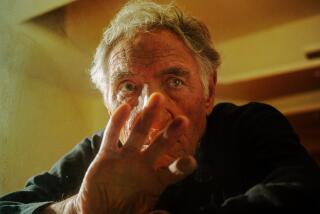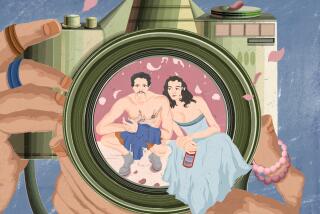Balthazar Korab dies at 86; architect-photographer with wide-ranging eye
Balthazar Korab, an architect-turned-photographer with a wide-ranging eye whose moody, polished images captured the spirit of midcentury modern architecture and celebrated its masters, including Eero Saarinen and Mies van der Rohe, died Jan. 15 in Royal Oak, Mich. He was 86.
Korab, who lived in Troy, Mich., died after a long period of decline caused by Parkinson’s disease and a stroke, said his son, Christian Korab.
A refugee from Communist-controlled Hungary, Korab came to the United States in 1955 and found work as a designer in Saarinen’s Bloomfield, Mich., office. His facility with a camera quickly turned his career away from designing buildings to documenting them through a lens.
PHOTOS: Architect-photographer Balthazar Korab | 1926-2013
Like Julius Shulman and Ezra Stoller, Korab became one of architecture’s most eminent photographers. During a career that spanned six decades, he produced evocative images of modernist icons, including Saarinen’s curvaceous TWA Terminal at New York’s John F. Kennedy International Airport and Minoru Yamasaki’s World Trade Center.
“He looked at architectural photography like an architect, not just like a photographer,” said architect Cesar Pelli, who met Korab in the mid-1950s when both were young associates in Saarinen’s office. “He understood what buildings were about, what their intentions were. I believe he tried to capture that in his photographs.”
Modernist monuments were not the sole beneficiary of Korab’s roving eye. His camera captured the clash of rural and urban America, a disastrous flood in Florence, Italy, the rooftops of Rome, car culture and trees that his lens transformed into art.
PHOTOS: Notable deaths of 2013
“My father couldn’t put down a camera,” said Christian Korab, who also is a photographer. The senior Korab took more than 500,000 photographs during his career, all of which are now in the Library of Congress.
About 2,000 of the images portray a single gem of modernist architecture, a house Saarinen designed for industrialist J. Irwin Miller and his wife Xenia in Columbus, Ind. Korab shot the Miller House repeatedly over the course of 40 years.
“He said every time he went back it was different,” said John Comazzi, an associate professor of architecture at the University of Minnesota, whose book “Balthazar Korab: Architect of Photography” was published last year. “He had an understanding of architecture that it was always ... transforming through light, atmosphere or the activities taking place. He understood that a building was not static but ... to a certain extent, alive.”
Korab’s work was often suffused with melancholy, “or at least the sense that the world is not ideal,” Comazzi observed. The flaws of humans are suggested in the shadows falling over a modern downtown vista and the dark canopy of trees framing a well-preserved Louisiana mansion from the slave-holding era.
Such emotion may have roots in the dramas of Korab’s youth. Born in Budapest on Feb. 2, 1926, he was the third of four sons of a well-to-do grain broker and his aristocratic wife. He wanted to be a painter, but his parents pressed for a career in medicine or law. Architecture was a compromise.
Before he could pursue his training, however, German troops invaded Hungary in 1944. When the Soviet army advanced on Budapest in early 1945, Korab and his family fled their home above the Danube River. Among the few items Korab saved was a Leica camera his father had bought from a retreating German soldier.
Hungary under Soviet rule was inhospitable to many capitalists, including Korab’s father, who was imprisoned for several months in 1948. After his release, he launched plans for Korab to leave the country. On New Year’s Day in 1949, Korab began a long trek to Austria, trudging for hours over snow-covered terrain with a white sheet for camouflage.
He eventually made his way to Salzburg, the seat of the American occupation, where he got a job in a photo lab that served enlisted men and women.
In 1950 Korab moved to Paris. He studied architecture at the Ecole des Beaux-Arts and worked as a draftsman for Le Corbusier, the pioneer of modern architecture. He earned his degree in 1954.
That year he met an American woman, Sally Dow, who was from Royal Oak, Mich., and married her in Paris. She persuaded him to move to Royal Oak. Their marriage ended in divorce.
In 1960 Korab married Monica Kane, who became his business manager and archivist. She survives him, along with their two children, Christian and Alexandra.
Korab went to work for Saarinen in 1956, when the firm was immersed in the TWA project. His skill with the camera made him a unique asset to the design team as they plotted out the terminal’s sculptural forms and complex spaces. Long before computer-aided design, Korab literally used smoke and mirrors to create photographs of large-scale models of the building. The photos were so effective at giving the client a sense of being in the space that, Korab said in Comazzi’s book, “they bought the whole project without even seeing the model.”
His photography for the TWA project “effectively ended his career as a practicing architect,” Comazzi wrote. He left Saarinen’s office in 1958 and concentrated on architectural photography noted for its artistic approach to its subjects. In 1964 his efforts brought him the American Institute of Architects Medal for Architectural Photography.
In 1994 he curated a collection of photographs that President Clinton gave as a state gift to Hungarian President Arpad Goncz. Korab’s choices offered a glimpse of what he saw as the good and bad in American culture, juxtaposing images of architectural masterpieces with a lonely prairie schoolhouse and an urban patch cluttered with neon signs and power lines.
“He was once asked to describe his own work,” Comazzi said. “He said it was soft-spoken with a bite. He was incredibly charming, a gentleman of another era. But, having been an outsider, he understood the flaws in American culture and was willing to represent both sides.”
More to Read
Start your day right
Sign up for Essential California for the L.A. Times biggest news, features and recommendations in your inbox six days a week.
You may occasionally receive promotional content from the Los Angeles Times.







